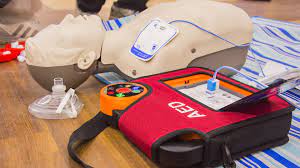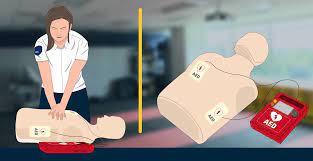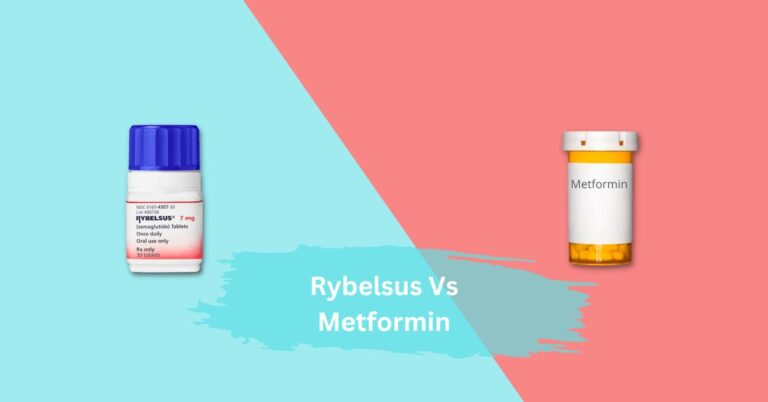When Should The Rescuer Operating The Aed Clear The Victim
AED stands for Automated External Defibrillator. Using an AED means giving a shock to the person in need. However, ensure no one touches the victim during the process, and it is safe.
This article will guide you about the importance procedure and uses of AED. So just stay with us till the end.
What Is An AED? – For Those Who Don’t Know!
An AED, short for automated external defibrillator, is a small, portable device. It gives an electric shock to the heart through the chest. This shock can help fix an irregular heartbeat during sudden cardiac arrest (SCA).
SCA is when the heart suddenly stops working right and can be deadly if not treated fast. Using an AED quickly is crucial because every minute without it reduces the chance of survival by about 10 percent.
Why Is Access To An Aed So Important? – Understand Its Significance!

Here are some essential things to do to improve the chance of survival:
- Learn CPR and how to use an AED properly. Being trained ensures you do everything right, which is best for the person having a cardiac arrest.
- Call emergency services right away and tell them what’s happening. Say, “Someone’s heart stopped, and we’re doing CPR. Please come quickly.”
- Start CPR fast and keep doing it. This helps get oxygen-rich blood flowing to the brain and other important organs.
- Keep AEDs handy with the emergency team and their plans so they’re ready to use immediately.
Types Of AED – Explore The Diversity!
- Fully automatic: AEDs are designed to deliver a shock without the user triggering it manually. Once the device analyzes the heart rhythm and determines that a shock is necessary, it will automatically administer the shock without any additional input from the user.
- Semi-automatic: AEDs require the user to press a button to deliver the shock. While the device will still analyze the heart rhythm and prompt the user, the shock will only be delivered once the button is pressed.
Both types are made to be simple to use, have instructions on the screen, and are said aloud to help you know what to do.
Consideration Before Using An AED? – Must Consider Them!
Don’t use an AED on someone having a heart attack if they’re still awake and breathing. Before using the AED or giving a shock, make sure:
- The person isn’t breathing or awake. If they’re not, get them ready for the shock.
- Nobody’s touching the person while the AED checks their heart rhythm.
- After the AED says “shock,” again, ensure nobody touches them. Then, press the shock button.
How To Use An AED? Steps-By-Step Guide!

1. Using An Aed On Adults:
- Call for Help: If someone collapses, call 911 right away.
- Turn on the AED: Press the power button and follow the instructions.
- Follow AED’s Voice Commands: Listen carefully and do as it says.
- Prepare the Person: Take off their shirt and dry their chest.
- Apply the Pads: Put them on their chest as shown in the pictures.
- Analyze the Heart: Let the AED check their heart rhythm without anyone touching them.
- Follow AED’s Instructions: Ensure nobody touches them if it advises a shock. Press the button. If not, start CPR.
- Start CPR: If no shock is advised, do chest compressions and rescue breaths as guided by the AED.
- Keep Going: Keep doing CPR until help arrives.
2. Using An Aed On Children:
- Turn it On: Switch on the AED.
- Expose the Chest: Remove any clothes covering the chest.
- Put on the Pads: Place them on the chest as directed.
- Analyze the Heart: Let the AED check their heart rhythm.
- Shock if Needed: If it advises a shock, press the button.
- Do CPR: If not, do chest compressions and rescue breaths.
- Keep Following the AED: Keep following its instructions until help arrives.
Remember, using an AED quickly can save lives. Make sure to stay calm, follow the steps, and act fast. Also, remember the differences in using AED on children: put the pads differently and do chest compressions at a different depth.
Frequently Asked Questions:
1. Do you have to do CPR before using an AED?
Yes, using CPR along with an AED improves the chances of survival. Keep doing CPR until the AED arrives and continue until professional medical help gets there.
2. Are there instructions in an AED?
Yes, AEDs come with manual instructions, but modern ones also have voice commands. These commands analyze the victim’s situation and give instructions accordingly.
3. Can you use an AED on a pregnant woman?
Yes, it’s safe to use an Automated External Defibrillator (AED) on a pregnant woman having sudden cardiac arrest. The American Heart Association (AHA) says it’s important for both her survival and the survival of her unborn child.
Conclusion:
When using an AED, check the heart rhythm before doing anything. This helps you know what you’re dealing with. Also, wait until you’re sure no one is doing CPR before preparing the AED pads for giving a shock. Then, deliver the shock once you’re sure it’s safe.
Also Read:







